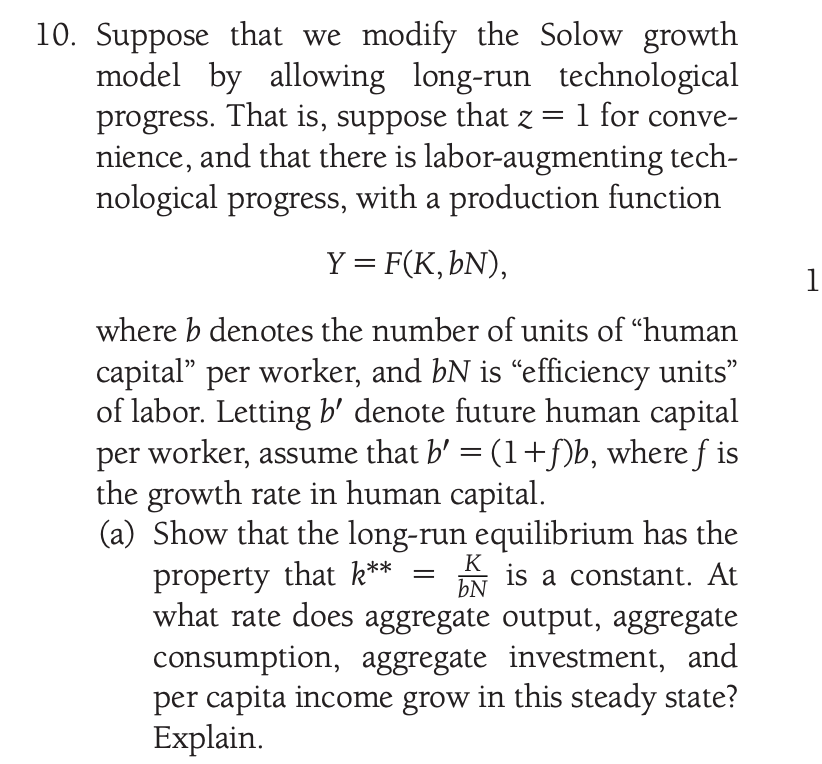10. Suppose that we modify the Solow growth model by allowing long-run technological progress. That is, suppose that z = 1 for conve- nience, and that there is labor-augmenting tech- nological progress, with a production function Y = F(K, bN), where b denotes the number of units of "human capital" per worker, and bN is “efficiency units" of labor. Letting b' denote future human capital per worker, assume that b' = (1+f)b, where f is the growth rate in human capital. (a) Show that the long-run equilibrium has the K property that k** what rate does aggregate output, aggregate consumption, aggregate investment, and per capita income grow in this steady state? Explain. is a constant. At bN
10. Suppose that we modify the Solow growth model by allowing long-run technological progress. That is, suppose that z = 1 for conve- nience, and that there is labor-augmenting tech- nological progress, with a production function Y = F(K, bN), where b denotes the number of units of "human capital" per worker, and bN is “efficiency units" of labor. Letting b' denote future human capital per worker, assume that b' = (1+f)b, where f is the growth rate in human capital. (a) Show that the long-run equilibrium has the K property that k** what rate does aggregate output, aggregate consumption, aggregate investment, and per capita income grow in this steady state? Explain. is a constant. At bN
Chapter1: Making Economics Decisions
Section: Chapter Questions
Problem 1QTC
Related questions
Question

Transcribed Image Text:10. Suppose that we modify the Solow growth
model by allowing long-run technological
progress. That is, suppose that z = 1 for conve-
nience, and that there is labor-augmenting tech-
nological progress, with a production function
Y = F(K, bN),
1
where b denotes the number of units of "human
capital" per worker, and bN is “efficiency units"
of labor. Letting b' denote future human capital
per worker, assume that b' =(1+f)b, where f is
the growth rate in human capital.
(a) Show that the long-run equilibrium has the
property that k**
what rate does aggregate output, aggregate
consumption, aggregate investment, and
per capita income grow in this steady state?
Explain.
K
is a constant. At
bN
Expert Solution
This question has been solved!
Explore an expertly crafted, step-by-step solution for a thorough understanding of key concepts.
This is a popular solution!
Trending now
This is a popular solution!
Step by step
Solved in 2 steps

Knowledge Booster
Learn more about
Need a deep-dive on the concept behind this application? Look no further. Learn more about this topic, economics and related others by exploring similar questions and additional content below.Recommended textbooks for you


Principles of Economics (12th Edition)
Economics
ISBN:
9780134078779
Author:
Karl E. Case, Ray C. Fair, Sharon E. Oster
Publisher:
PEARSON

Engineering Economy (17th Edition)
Economics
ISBN:
9780134870069
Author:
William G. Sullivan, Elin M. Wicks, C. Patrick Koelling
Publisher:
PEARSON


Principles of Economics (12th Edition)
Economics
ISBN:
9780134078779
Author:
Karl E. Case, Ray C. Fair, Sharon E. Oster
Publisher:
PEARSON

Engineering Economy (17th Edition)
Economics
ISBN:
9780134870069
Author:
William G. Sullivan, Elin M. Wicks, C. Patrick Koelling
Publisher:
PEARSON

Principles of Economics (MindTap Course List)
Economics
ISBN:
9781305585126
Author:
N. Gregory Mankiw
Publisher:
Cengage Learning

Managerial Economics: A Problem Solving Approach
Economics
ISBN:
9781337106665
Author:
Luke M. Froeb, Brian T. McCann, Michael R. Ward, Mike Shor
Publisher:
Cengage Learning

Managerial Economics & Business Strategy (Mcgraw-…
Economics
ISBN:
9781259290619
Author:
Michael Baye, Jeff Prince
Publisher:
McGraw-Hill Education